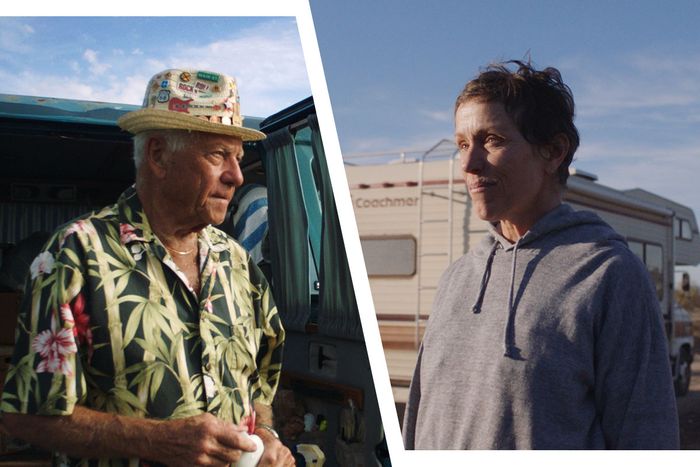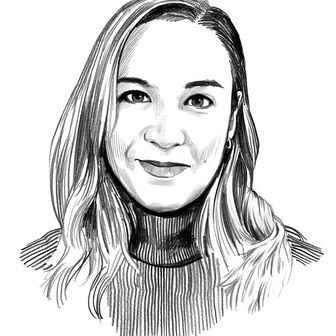
Inside God’s waiting room, an abnormality bides his time. Dennis Dean resides in the Villages, the nation’s largest retirement community, but only in the most tangential sense. He does not live anywhere, precisely; his home is a van, and it is also a hunting blind. He is looking for women and for something else. He wants security, he says in Some Kind of Heaven, Lance Oppenheim’s new documentary about Florida’s strangest enclave. At 83 years old and on the run after an out-of-state drunk-driving fine, Dean sees that his goal is almost beyond his reach. “What I’m looking for is a companion, a nice-looking lady with some money,” he says bluntly. He needs a home, and for that, he needs a wealthy girlfriend.
Widows abound in the Villages, and so does money. But the “classic lady” of his dreams is “rare,” Dean complains, so he becomes a poltergeist. He haunts the bars, the churches, the swimming pools. His van rattles down well-groomed roads, a reminder that all is not well outside the Villages.
Within the Villages, a figure like Dean is almost unthinkable. The place isn’t meant for him. Homes aren’t cheap, and the community itself is privately owned and managed by a holding corporation. Designed to evoke a particular nostalgia — “an old-fashioned town center, the kind we all grew up in,” founder Harold Schwartz says in a historical clip — the Villages attract a specific resident. Mostly white, mostly well-off, and mostly Republican, Villagers expect the America that Reagan once promised them: a shining suburb in a swamp. Schwartz says would-be residents have one question for him. They want to know the town’s “story line,” its “reason for being.” So he appealed to an old Florida fantasy. He told them that inside the Villages, a person could find the Fountain of Youth.
Nobody knows whether the Spanish explorer Juan Ponce de León really set out to search for the Fountain of Youth in Florida or if he, like Dean, wanted more immediate pleasures: land, gold, fame. The New World looked like a promise from Spain, and from Dean’s former home in California, so too did the Villages. But the town does not reward Dean’s exploratory spirit. This isn’t a gated community, a woman tells the filmmakers; instead, think of this as a community with gates. Dean finds out exactly how hard those white gates can swing. “I kept seeing this guy sneaking around and looking at me in his golf cart,” he says. Then a note appeared on Dean’s van: “I know you don’t live here. If you want to avoid trouble, don’t come back.” The Villages are private property, and if poverty exists, it can be pruned.
The Villages are more biosphere than town. “You don’t have to go outside the Villages,” one man observes, and this is a selling point. There is a hospital; the town website says it’s one of the fastest-growing acute-care centers in the country. There is a TV station, a radio station, a newspaper. Everything is green. Everything is calm. Everything is just the way the residents like it. “I don’t see the slums,” one says early in the film. “I don’t see death and destruction. I don’t see murders.” Almost as an aside, he adds, “You don’t see a lot of children running around here, either.” Growth in the Villages trends in only one direction, inching closer to God and Judgment in the least-challenging circumstances possible.
Then there is Dean, a snake in a van, a living reminder that the world outside the Villages can be unkind and even unreasonable to those of a certain age. He makes the fantasy impossible to sustain. He ruins the story line. “The history here in the Villages — there’s a real history and then there’s the made-up history,” an heir of Schwartz says. The Spanish-mission-style architecture is all fake. The Villages aren’t organic but a cynical capitalist creation and a selective one at that. Outside the town limits, reality can look like an old van.
Both Some Kind of Heaven and Nomadland, Chloé Zhao’s Academy Award–nominated new film, arrive at a moment of crisis for American seniors. COVID is particularly hard on aging bodies, but its biological complications are not evenly distributed across all racial and economic demographics. Not only has the virus claimed Black and brown seniors at higher rates, it has swept through nursing homes and assisted-living facilities, and in so doing, it has illuminated an older epidemic: The poorer seniors happen to be, the less likely they are to receive high-quality care. COVID did come to the Villages; it reported an October spike in cases. Its residents could take advantage of a “vigorous” testing program administered by the University of Florida. It’s hard to know how the nomads fared by contrast, whether their isolation protected them in the pandemic. The off-the-grid nature of their lives makes them difficult to track, but the answer probably isn’t a pleasant one. Vans don’t have on-site hospitals.
In Nomadland, vans are the whole of the world — their interiors, darkly lit and packed with a few precious possessions; their exteriors, plain-painted and elongated; their residents, who entered middle age (or later) without substantial means; their names. Fern, the film’s lonesome hero, calls hers Vanguard. When the vans break down, so do the people who call them home. Suburbia makes a single brief appearance when Fern runs out of funds and makes a complicated trip home to see her younger sister. In this fictionalized adaptation of journalist Jessica Bruder’s nonfiction book of the same name, a fleet of so-called nomads drive from seasonal job to seasonal job, never staying in one place for long. They are undesirables, cousins to Dean.
Nomadland shows an America that the Villages wants to keep out — wants to deny altogether. Age into poverty and nothing waits to catch you when you fall. Sometimes there’s only a van. In both films, the government is a nonentity. Fern is briefly shown in a benefits office, where she rejects an early-retirement check because she can’t afford to live on it. In the Villages, no one talks about the government at all, though most there are eligible for social-security benefits. The town strives for total self-containment, a feat made possible by the wealth of its residents. Fern, meanwhile, depends on menial labor; when she finds security of any kind, it’s mostly through Amazon. She belongs to the corporation’s CamperForce program. To entice aging RV and van dwellers (a website for the program looks like a Cialis ad), Amazon covers some campground expenses for a temporary work assignment. When Fern’s Amazon job ends, she’s on the move again, drifting from job to job until the holidays reappear and it’s time for Amazon again. “I think that what the nomads are doing is not all that different from what the pioneers did,” Fern’s sister, Dolly, says toward the end of the film. “I think Fern’s part of an American tradition. I think it’s great.”
In the world of Nomadland, Fern’s Amazon warehouse juts up from a bare landscape. Inside, it’s as pristine as anything in the Villages, all bright lights and clean floors. When Fern leaves and goes home to her cramped van, the viewer’s eyes almost have to readjust to the dark. There, she feeds an old, sharp nostalgia: for her late husband, for his old job at a Nevada gypsum mine, for the company town that turned ghost town when the mine finally closed. Alone in the night, it’s easier to imagine a different kind of life.
Even at its most abstract, fantasy reflects back on the dreamers and is never entirely detached from the truth. The Villages exist because people feared the world outside it and had the means to build an alternative. Fantasy is less visible among the nomads, but it’s not totally absent, either. In the limitations of their circumstances, they elect to see freedom. Fern names her van out of pride and surrounds herself with comrades who extol the virtues of their van-dwelling lifestyle. But the film is complicit in another fantasy: It offers up pristine images of Fern’s Amazon workday and omits the reality. Fern never suffers from sore feet or leg cramps. Nobody docks her time for going to the bathroom. Her coworkers don’t get fired for leading protests at work; in fact, there are no protests at all.
Had Nomadland looked at Amazon for what it truly is, what it does to workers, and what its near omniscience tells us about the failures of the American state, it would have discovered a truth as spare as the landscape it loves. Even on the open road, freedom is scarce. It’s a casualty of other forces, like the long, successful war to starve the American state until it’s too small to help people like Fern. Residents of the Villages have helped that war along: In 2016 and again in 2020, the town was a Trump stronghold, and Republicans reportedly outnumber Democrats there two to one.
Between the poles of Nomadland and Some Kind of Heaven, the real America shows up — not a country, barely even a society. There are different Americas for different kinds of people, and they can vary so widely from each other that they may as well be different planets, too. The tropical campus of the Villages looks a world apart from the rock-and-brush watercolors of the nomad life, in part because it is. The residents of the Villages have gated themselves off from everyone else. Abandoned with age to whatever fate their bank accounts can purchase, they hoard a little security inside a bubble. Outside the gates, it’s every Fern for herself. The same villain oppresses both films, though it never receives a name. It’s not the man who briefly runs off Dennis Dean but the force that empowers him, which also enables Amazon and turned Fern’s home into a ghost town. Capitalism devoured America from the inside out and then spat out the bones. What’s left behind is bare rock and a white gate.





